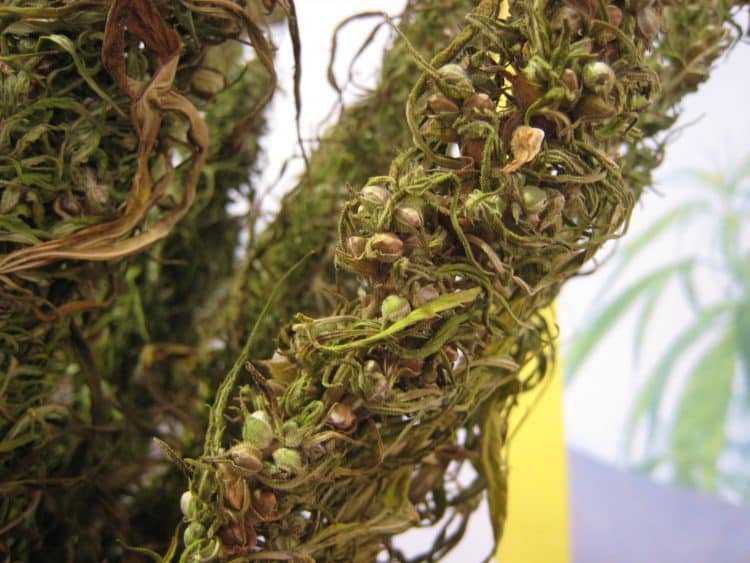During our 2019 conference Concentration, Frenchy Cannoli provided a passionate keynote seminar in which he called out the cultivation of hemp just for cannabidiol (CBD). The plant can offer much more, such as terpenes and minor cannabinoids. Stalks can be used; seeds can be eaten. Maybe one day, the packaging used will also be made from hemp.
It’s unsettling to think about the waste heaps already generated in state and federally legal markets. Never-ending seas of packaging, discarded biomass that must be rendered useless or incinerated, and spent solvents can sully the credentials of an industry that strives to be green.
A 2019 study sought to optimize cannabinoid extraction from industrial hemp that had gone through the threshing process. [1] Threshing refers to the process where seed and fiber are separated from bulk biomass. Cultivators growing hemp for traditional industrial purposes like hemp seed oil production might be discarding stockpiles of cannabinoids in their waste biomass, squandering good phytomedicine.
The researchers evaluated threshing residues containing hemp stalks and leaves. They employed supercritical carbon dioxide extraction to pluck what they could from the biomass. They ran the extraction at 45°C and varied the pressures between 10 and 45 MPa, or 100 and 450 bar. The system utilized two separators, one at 4 MPa and one at 8 or 9 MPa, to fractionate the extract. Terpenes were extracted first using 10 MPa and 60°C. Then, the 45 MPa and 45°C conditions were set. The initial solvent-to-feed (S/F) ratios were 55 to 65 kg CO2/kg feed. The highest mass yields (5.5 and 5.2% from Sample 1 and 2, respectively), however, were obtained using S/F ratios greater than 100 kg CO2/kg feed.
When the separators were employed, the researchers used 20 MPa and 45°C, returning mass yields of 3.5% from separator 1 (higher pressure) and 1.5% from separator 2 (low pressure) at a S/F of 40 kg CO2/kg feed.
Once the extracts were de-watered, the researchers turned to gas chromatography/mass spectrometry to quantify the cannabinoids. Normally, the temperatures used inside of the GC decarboxylate acidic cannabinoids like cannabidiolic acid (CBDA) into their neutral offspring like CBD. A way around this is to derivatize the acidic cannabinoids so they don’t degrade with increased temperature. This is often done by silylation, which involves reagents called silanes that contain silicon atoms. The reaction involves the active hydrogens on the -OH functional group of the acid. The hydrogen atom vacates, and the silyl group takes its place.
CBDA, CBD, Δ8- and Δ9-tetrahydrocannabinol (THC), and tetrahydrocannabinolic acid (THCA) extraction increased with higher pressure (45 MPa versus 20 MPa). Extracting the THC cannabinoids and cannabinol concentrated them approximately 100 times from their levels in the biomass. To further refine the method, the researchers compared cannabinoid yields at 25, 35, and 45 MPa. The study found that 35 MPa was enough as 45 MPa resulted in similar or lower cannabinoid yields. CBDA and THCA levels were highest at 35 MPa. Δ8- and Δ9-THC, and CBN were extracted to similar concentrations across all three experimental pressures. The highest concentrations of cannabinoids pulled from the hemp threshing residue were 788 mg CBD/100 g feed, 1661 mg CBDA/100 g feed, 19 mg/100 g Δ9-THC, and 46 mg/100 g THCA. [1]
This study exemplified the garbage to gold mantra. Rather than abandoning good biomass after stripping it of fiber and seed, the researchers found further utility for their plants by squeezing out cannabinoids and terpenes. Hopefully, hemp farmers and processors will harness innovative uses for their stalks and raffinate such that no parts of these special plants are wasted.
References
- Vági, E. et al. “Cannabinoids Enriched Extracts from Industrial Hemp Residues.” Periodica Polytechnica Chemical Engineering, vol. 63, no. 2, 2019, pp. 357-363. [journal impact factor = 1.447; cited by 0]
Image Credit: Wikicommons, By D-Kuru – Own work, CC BY-SA 3.0 at, https://commons.wikimedia.org/w/index.php?curid=4999101











